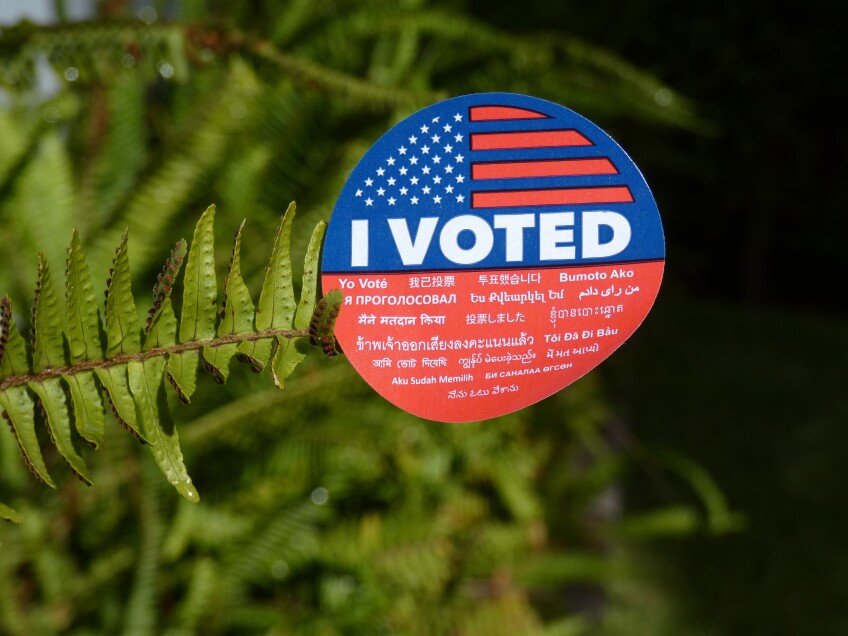An Election Season Thought Experiment: Imagine a Democracy Of the Plants, By the Plants, For the Plants

This is the first article in a series of collaborations with Jonathon Keats and Henry Jenkins and their project of bringing democracy to plants, in collaboration with the Civic Paths working group at the University of Southern California.
What if the results of the next election weren't determined by the left, the right or even swing voters?
What if they were decided by plants?
That's an idea put forth by "experimental philosopher" and conceptual artist Jonathon Keats. He envisions a world in which plants have the same voting rights as humans.
All living beings, he suggests, should have a role in our democracy.
Without thriving plants, humankind would cease to exist — yet their livelihood is not often considered outside of environmental and agricultural lawmaking.
Keats argues that every piece of policy, no matter how distantly related it may seem to ecology, has an effect on our environment. A bill on property taxes, for instance, should consider plants as the primary stewards of the lands being regulated — not the developers who have built atop their ecosystem.
If trees, grasses and other plants were enfranchised, they could vote to enact new zoning laws, limit the use of concrete or require more environmental protections in new development projects.
Keats has long argued that plants are intelligent creatures — and therefore have the capacity to actively participate in democracy. Through his art, he has sought to change our culture in ways that lead people to see plants as their equals.
In Cinema Botanica, Keats made movies for plants, including a travel documentary that allows them to experience foreign skies vicariously.

He also opened a photosynthetic restaurant, in which foliage feasted upon sunlight filtered through colored panels — since, based on scientific research, different parts of the light spectrum impact photosynthesis.
But he cannot create a futuristic, plant-based democracy on his own. Keats wants to share his ideas with plant lovers, policy makers and provocateurs — anyone who can help build this future.
That's why Keats is collaborating with the Civic Paths working group at the University of Southern California to bring this thought experiment to the public and sketch its potential in reality.
Plants and the Civic Imagination
A subgroup housed under the larger Civic Paths research initiative at USC, The Civic Imagination Project was created by Henry Jenkins, Provost Professor of Communications Journalism, Cinematic Arts and Education at USC Annenberg School for Communication and Journalism and Sangita Shresthova, who serves as its director of research. Through playful workshops and deep conversations, they discuss civic issues in diverse, often underrepresented, communities.
"People block their ability to imagine a longer-term future, frustrated by the realities at hand. If we could get beyond the tyranny of the possible in our imaginations, we find an enormous amount of consensus about what an ideal future would look like. Many believe that a better world is not possible and so they stop working to achieve it," Jenkins said.
Many believe that a better world is not possible and so they stop working to achieve it.Henry Jenkins, Primary Investigator, Civic Paths Research Group
To jumpstart a conversation about the future, Civic Imaginations begins with the past. Jenkins and Shresthova often start a dialogue by asking people to focus on memory objects, something that evokes special significance to the beholder. The memories tied to these objects often represent values and emotions that people want to preserve in a new world. In another activity, they help people personify non-human things, like plants, and consider what their existence will be like long after they've left this world.
The discussions around memory objects become valuable data in research about imagination. In a recent workshop, Jenkins recalls one subject's story about traveling with their dying father at the end of fall and building a metaphor that connected him to the withering hollyhocks. They wrote: "His blossom was gone, and now he's returning to seed."

"There's just so much poetry in those conversations from perspectives that we don't hear," Jenkins said. "We’re trying to surface those voices and see what they might teach us about that intersection between plants and humans."
Once plants become personified, it's much easier to view them as a political entity. Though they can't literally speak, that doesn't mean they don't have a voice. As Jenkins pointed out, there are many groups that already advocate on behalf of disenfranchised communities, like children, immigrants and people who are incarcerated.
The people who care most about plant welfare may be those who are already engaging with the environment. This could be anyone from climate activists to the hobbyist gardener.
Jenkins noted that his late mother painted pictures of flowers and tended to a rock garden — but she never spoke of the environment as a political issue.
"Conversations through plants is one way of people from different spaces, who may not think of themselves as civic agents, have conversations about something that doesn't feel political, but is very embedded within a political context," said Paulina Lanz, a member of the Civic Imaginations project and a PhD student in Communication at USC.
Power to the Plants
When Keats helps people envision the way plants may vote, he poses a question for plants that most people already ask themselves when there's an upcoming presidential election: "Are you better off now than you were four years ago?"
Of course, plants can't answer that question with words, but there's another option: Scientists could measure plants' satisfaction with the present political situation by studying their biochemistry or observing stages in their life cycle (a.k.a. phenology).
For example, when stressed, a plant's growth patterns may change — a phenomenon associated with the release of higher amounts of the hormone ethylene. That could, for example, cause a plant to flower prematurely.
Compare flowering times year to year, and we might be able to determine if the environment has become more hostile from their perspective.
But, just like humans, plants don't universally have the same interests — and their desires won't fall neatly along party lines.

With a little imagination, we can picture that a drought-stricken lawn might want more irrigation, even as cities tighten watering hours to mitigate drought; a tree scorched by a wildfire may want to return to controlled burning, even though the practice has been outlawed in some areas; and a crushed poppy in the Antelope Valley might want to shut down access to its reserve, spoiling the plans for thousands of tourists every spring.
How would our interaction with the environment change if we knew how plants would vote?
Keats and the Civic Paths group plan to roll out their first community projects within the next few months. They hope to show people how plants change season by season in a phenological tour of Los Angeles, to connect with local community gardens and to spark conversations about their favorite plants from popular culture.




